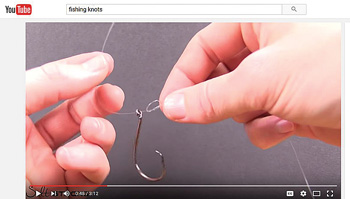The basics of tying knots

SUbmitted
An example of just one of the knots you can learn online
via a YouTube video.
Your fishing tackle can be the best money can buy. You can use the perfect bait, lures and flies, but get one of the smallest details wrong and all your effort can be in vain. One of the most important components that can mean success or failure has never changed and that's tying your knots correctly. The average angler doesn't need many knots, but it's critical that they be tied properly. Learning to tie knots correctly may seem a minor part of the fishing equation, but you won't meet many anglers who haven't lost a great fish to an improperly tied knot!
The place to learn and practice knots is at home and not on the water. With some practice, you'll be able to learn a number of important knots with good instruction, a pair of pliers and some spools of line. Then when the action is hot, you'll be ready to tie that all important connection between you and your fish. Below are a few tips on tying knots that won't fail you and that will handle most every fishing situation you'll encounter in the Gulf or on the bay.
There are a few critical factors to tying knots that won't fail. First, make sure you give yourself plenty of line to make the knot. If you use too little line, you'll cut corners if you're in a hurry. This will also make learning to tie them a lot less frustrating. You can master the most complicated knots, but if you don't tie them properly they'll have a high probability of failing. The most critical component of any knot is that it is tight.
Knots break when they slip. To make sure they're secure, wet them when they are secured and make sure they're tight and won't slip when pressure is applied. I suggest using an eye bolt attached to a bench when rigging at home and a small eye hook on your boat console. Tie the knot, wet it and tighten it with a pair of pliers. Finally, test the connection with a strong pull, just shy of breaking the line. Follow these rules, tie the knots that work for you, and you'll strengthen the weakest link in your fishing experience.
Here are just a few of the many knots available, but good ones to master. The surgeon's knot is one of the easiest knots to tie, is very effective and can be used to tie tapered leaders under 60 pounds. This is the knot to use when tying two lines of dissimilar diameters together fast or in the dark. The surgeon's knot is really just an overhand knot tied with two strands of line. It is one of the most important knots you can learn.
The uni-knot is another simple knot that can be used to construct leaders as well as tying a hook to your bite tippet. This is probably the most popular knot tied locally. It's not rated at 100 percent, but I've never had a properly tied one fail.
The Albright special is an especially useful knot for the coastal angler. This is the knot to tie when you're rigging for Spanish mackerel or tarpon. It allows you to tie mono to wire without a swivel and lets you join 20-pound line to a 100-pound leader.
One knot that I avoided for years, but recently mastered is the blood knot. Preferred by most Keys guides for building leaders, this knot has a slim profile that easily slips through the guides of a rod.
The Bimini twist is another great knot to master. It may take some time to learn, but it can be used as a foundation for all saltwater leader systems. The Bimini allows you to double your standing line into a loop, creates 100 percent knot strength and acts as a shock between small line and heavier leader.
An easier knot to tie that is an effective way to double the standing line is the spider hitch. It doesn't have the knot strength of the Bimini twist but again, I've never had a properly tied one fail.
The final step is to tie a hook or lure to the leader. The Non-slip mono loop is my choice for several reasons: it's easy to tie, tests near 100 percent and forms a loop that gives bait and lures more range of motion. The knot has a couple of other advantages: it won't tighten when a fish is hooked, and the tag end comes out facing away from the standing line which keeps it from picking up weeds or other debris. The uni-knot also can be used to tie the hook to the bite tippet, but has the disadvantage of tightening down when pressure is applied.
There are a lot of YouTube videos with instructions on tying every imaginable knot. "Fishing Knots," by Lefty Kreh is one of the best I've seen on the market. It's spiral bound, so it easily stays open to the page you're studying, and no one I've met has the wealth of experience of Kreh. As a bonus there's a one hour DVD included where you can follow Lefty tying all the most important knots. The movie is peppered with invaluable tips on line, leader and knot tying. You can order the book by going to Stackpolebooks.com. Learn a few of the basic knots, tie them correctly, and you'll add a whole new dimension to your angling experience.

